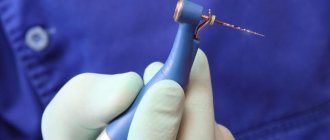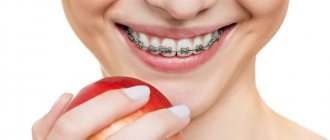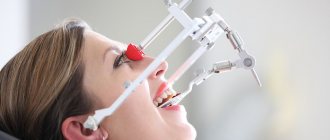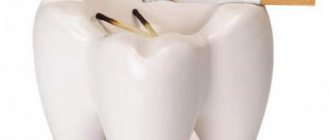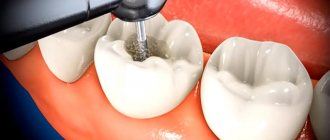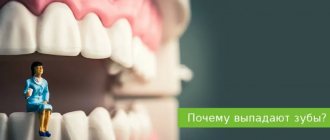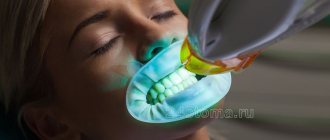249
The impeccable functioning of the human dentofacial apparatus is possible only with the complete integrity of the jaw rows.
The absence of even one element triggers a process of negative morphological and functional changes, which become increasingly worse over time.
These changes can be prevented only through timely prosthetics of the defect. Delaying it can lead to serious consequences, information about which is brought to your attention in the article below.
General concept
The Popov-Godon phenomenon (P-G) is a pathological restructuring of the dentoalveolar processes due to tooth loss or, in other words, a violation of the integrity of the rows.
The pathology got its name from the dentists who first described it. Namely, the Russian scientist O.V. Popov, who observed in 1880 the deformation of the dentition of a guinea pig, whose incisors were removed, and Godon, who in 1904 described the deformations of the dentofacial apparatus of patients after the loss of elements of the jaw rows.
In addition, Godon is also known for proposing his hypothesis to explain the development of the phenomenon, which he called the theory of articular equilibrium.
The clinical picture of the P-G phenomenon is varied. One of the most easily recognizable manifestations of pathology is the vertical extension of the unit located opposite the defect from the alveolar process, its crown crossing the occlusal plane and entering the space of the defect.
In some cases, advancement continues until full contact with the surface of the gum of the opposite row. Units that are located next to the defect can tilt towards it, rotate around their axis, and shift in one direction or another.
The relationship between different types of pathological displacements in the Popov-Godon phenomenon made it possible to establish a study conducted on 120 young patients who had anomalies caused by adentia.
It turned out that medial displacement accounts for 45.1%, combined - 17.5%, palato-oral - 10%, distal - 9.5%, vertical - 9.5% described above, vestibular - 5 .5%, for tortoposition (rotation around an axis) – 2.2%.
In addition to visual, clearly visible manifestations of pathology, there are also hidden or less visible ones. They are expressed by a violation of the occlusal relationships of individual units, deformation of the occlusal plane, dentoalveolar enlargement and some other features.
The specific form of manifestation of the P-G phenomenon depends on a number of factors:
- Length and location of the defect.
- Time elapsed since tooth loss.
- Age of the patient (negative manifestations occur faster in children).
- General health.
- Conditions and characteristics of the jaw apparatus.
Delay in treating the P-G phenomenon threatens the patient with many negative consequences:
- Chewing dysfunction.
- Deterioration of smile aesthetics.
- Chronic articulation injury, fraught with the risk of malignancy.
- Blocking low frequencies.
- TMJ dysfunction due to overload.
- Impaired articulation and diction.
- Pain and discomfort in some clinical situations.
- Deterioration of treatment and prosthetic conditions.
The root cause of the Popov-Godon phenomenon is tooth loss, which can occur for various reasons - due to caries, periodontitis and other diseases, injuries, forced extractions.
As a secondary cause of displacement during edentia, one should consider the restructuring of the dentoalveolar process according to mechanisms that are still not completely understood.
There are different theories explaining this process. In particular, Hodon’s theory, mentioned above, is that the jaw apparatus is a system that maintains immobility with the integrity of the rows due to a closed chain of forces.
If at least one tooth is lost, the closed chain breaks, which causes multidirectional displacement.
There are other theories that explain the P-G phenomenon, but there is still no one that would be recognized by all experts.
Let's talk about the impact of bite on the face and the possibilities to correct the situation.
Come here if you are interested in the connection between bite and headaches.
At this address https://orto-info.ru/zubocheliustnye-anomalii/okklyuzii/ispravleniya-prikusa-viniryi-v-stomatologii.html find out whether veneers correct the bite.
General information
Dental pathology is not a serious disorder, but in the absence of proper treatment it can provoke some complications. The main reason for its development is considered to be the loss of teeth without subsequent implantation or prosthetics. According to research, more than 30% of patients who have had at least one tooth removed do not think about the implantation procedure.
This is how the phenomenon manifests itself when a tooth is lost
This is due to the fact that with such a minimal loss, the process of chewing food is not disrupted, so a person does not rush to the dentist. It is noted that 2-3 months after the removal of one or more units, a gradual displacement of healthy teeth begins. If a person does not visit a specialist for a year to install implants, the procedure will be quite problematic.
When one tooth is removed, the pathology develops quite slowly. If the number increases, rapid displacement of healthy teeth begins, elongation of the alveolar processes and other disorders:
- dysfunction of the muscles of the lower jaw;
- advancement of the upper or lower dentition;
- changes in the structure of the alveolar processes;
- exposure of the root of healthy units located directly next to the void;
- formation of a gum pocket around healthy teeth;
- dysfunction of the temporomandibular apparatus;
- narrowing of the periodontal fissure;
- changes in collagen fibers;
- dystrophic processes in the pulp;
- disturbance in the structure of the periodontium.
As a rule, several months or even years after the removal of one or several units, prosthetics and implantation become very complicated. It is for this reason that experts strongly recommend making a replacement no later than 10-14 days after extraction.
Classification and symptoms
The anomaly can lead to various types of movement, which seriously complicates the diagnosis of the pathology. The following types of movements are noted:
- Vertical – one-sided, two-sided, unidirectional, mutual. This type of movement is typical for both lateral and frontal units. A displaced unit can completely occupy the defect space, thereby blocking the horizontal movement of the NP.
- Tilts in the distal and medial direction - towards the defect.
- Tilts in the buccal and lingual-palatal direction.
- Rotation around a long axis.
- Combined offset.
- Dentoalveolar elongation.
The classification according to Ilina-Markosyan and Ponomareva provides for the division of the P-G phenomenon into two forms:
- 1st. It is characterized by dentoalveolar elongation while maintaining the ratio of the intra- and extra-alveolar parts of the tooth. There are no gum pockets, the neck is not exposed, periodontal resorption is absent or insignificant - no more than ¼.
- 2nd. The dentoalveolar elongation is approximately the same size as in the first form, but with exposure of the neck. Periodontal resorption is at least half. The extra-alveolar part of the tooth is enlarged in relation to the intra-alveolar part.
At its core, the second form is a more developed first. Therefore, the difference between the forms is rather arbitrary.
General overview
The Popov-Godon phenomenon is a complication after tooth loss, manifested by severe deformation of both dentitions.
The main manifestation of the phenomenon is that the teeth located opposite the defect move vertically, filling the void formed due to edentulism. Sometimes the protrusion is so significant that they reach the mucous membrane of the gums in the place of missing teeth.
The teeth located next to the defect also change their location; can rotate around an axis, tilt in any direction (vertically, distally, mesially, in the lingual and vestibular directions, or in the form of a combination of several movements). Pathological restructuring begins from the defect and then spreads to the entire row.
The severity of deformities depends on many factors - the number of lost units, the extent and location of the defect, the condition of intact teeth, the type of occlusion, the time that has passed since the loss of teeth, the patient’s health and age. Popov-Godon syndrome develops much faster in children than in adults.
The jaw arch is a single whole, working in harmony with the other elements of the dentofacial apparatus. Its deformation leads to traumatic articulation, diseases of the dental support system, and TMJ dysfunction . In addition, the uncorrected Popov-Godon phenomenon seriously complicates prosthetics.
When the pathology is severe, protruding teeth put pressure on the alveolar ridge, leading to chronic injury, which can malignize (become malignant). It is possible to block the lower jaw, leading to overload and disruption of the TMJ with pain.
Obviously, the cause of secondary deformations is the adaptation of the dentofacial apparatus to changed working conditions, the restructuring of the periodontium due to the lack of chewing load.
But the details of this process are still unclear. There are different theories explaining the deformation of rows during prolonged edentia. Theory of articulatory (author Godon) and relative physiological (Katz and Schroeder) balance, hypotheses of Kalvelis, Kurlandsky and others. But each of them has its critics.
The primary cause of malocclusion is, of course, tooth loss. It can be caused by vitamin deficiency, diseases of the oral tissues (caries, periodontitis, periodontitis), surgery, or injury.
Methods for treating crowded teeth in adults and children.
Come here to take a closer look at the Forsus device.
At this address https://www.vash-dentist.ru/ortodontiya/prikus/suzheniya-chelyustey-i-zubnyih-ryadov.html details about the narrowing of the jaws and dentition.
Diagnostic measures
The Popov-Godon phenomenon is diagnosed by examination, radiography (orthopantomography, teleradiography), and the study of diagnostic models. The latter must be made before treatment, during and after correction.
The following signs support the presence of the syndrome:
- Partial edentia.
- Distortion of the occlusal curve (there is a supra- or infraocclusal position in relation to the occlusal plane).
It is established on the basis of a teleroentgenogram and/or orthopantomogram (they draw the occlusal plane and see whether the crowns intersect it or not). - Dental alveolar enlargement in the area of displaced units.
- Absence of dentoalveolar reduction.
- Reduced distance between the chewing surface of the advanced units and the gingival mucosa of the opposite row. With severe pathology, the gap between them may be completely absent, creating a risk of injury to the mucosa.
- Periodontal resorption of varying degrees in the area of moved units (but it may be absent in the first form).
- Invariance of periodontal tissues, dentin and enamel.
One of the main diagnostic results is the statement of the fact that the displaced teeth intersect the occlusal plane. This is important for differential diagnosis.
In some pathologies that can be mistaken for the Popov-Godon phenomenon (for example, with pathological abrasion of chewing/cutting surfaces), the teeth do not intersect the occlusal plane.
What is the Popov-Godon phenomenon?
The Popov-Godon phenomenon is a dentofacial pathology, expressed in abnormal dental shifts provoked by tooth extraction and failure to timely prosthetize the defect (loss of an element of the dentition).
The syndrome was initially recorded in 1880 by V. O. Popov. Then, in 1904, Hodon also noticed a modification of the dentition due to the loss of some links.
Often, teeth without opposing counterparts move quite noticeably and almost come into contact with the mucous membrane of the alveolar process of the opposite side. The work of the muscles of the lower jaw is immediately blocked.
The Popov-Godon phenomenon in the photo:
The results of the analyzes indicate that such a syndrome rearranges the alveolar bones in dental units left without opposite analogues: the periodontal gap narrows, the routes of collagen fibers change. At the same time, certain dystrophic transformations occur in the pulp.
Such situations happen repeatedly and complicate the process of prosthetics, and therefore orthodontic devices have been created that are designed based on the category of removable or fixed dentures. Through them, teeth devoid of antagonists are allowed into occlusion, along with the synchronous separation of other links.
If there is a noticeable movement of the dental unit, the pulp is removed from it and trimmed within the occlusion curve. Significant exposure of cement provokes its extraction.
If it is necessary to wear the plates 18 hours a day, treatment will last at least six months and depends on the complexity of each individual case. If the effect of orthodontic treatment is less positive, prosthetics are performed.
About 30% of the population, having removed a tooth, often do not even think about restoring it, explaining this by disagreement with damaging neighboring links.
Physiologists, thanks to research, have found that when a tooth is lost, a person does not lose the ability to chew food well. But the body does not tolerate emptiness, and the neighboring teeth, moving, try to hide the gap, causing gaps to appear between themselves.
An even more serious situation is where the dental analogue from the opposite area grows towards the void, interferes with proper chewing and increases the functional load, which contributes to the modification of the bite.
Visual video about dental deformation:
Clinical picture
After extraction, a natural compensatory reaction of the body develops. It leads to quite unpleasant consequences - deformation of the dental arch, impaired chewing function, changes in bite and pathologies of the temporomandibular joint associated with overload of the musculo-ligamentous apparatus.
The more teeth are lost, the faster the accompanying disorders develop:
- change in occlusion and inclination of the dentition;
- the formation of a gum pocket and exposure of the roots of the teeth located adjacent to the socket of the missing unit;
- narrowing of the periodontal space;
- pulp dystrophy and changes in periodontal structure.
All these violations in the future significantly complicate the work of doctors if the patient nevertheless decides to install an implant or prosthesis.
Development mechanism
If a denture or implant is not installed, the adjacent teeth gradually move towards the missing unit. In addition, on the opposite jaw, its antagonist begins to “lengthen,” as it were.
The reason for this phenomenon is changes in the periodontium - the so-called adaptive restructuring caused by the loss of the usual functional load. It entails metabolic and microcirculation disorders in periodontal tissues.
At the beginning of the process, tissue hypertrophy occurs, and in the later stages, tissue atrophy occurs, accompanied by partial periodontal resorption.
This is interesting: What is a stump inlay for a crown - composition and types: cast and collapsible dentures
Symptoms
The removal of a tooth or several teeth causes a compensatory reaction on the part of the body, which is expressed in deformation of the dental arch and the jaw itself. Neighboring teeth begin to shift towards the missing one. As a result, the spaces between the remaining teeth increase. Not only the dentition in which the tooth is missing is deformed, but also the dentition of the opposite jaw. With the Popov-Godon phenomenon (syndrome), a significant displacement of the tooth in the opposite jaw occurs. The tooth seems to “grow” from the dental arch and creates a “lock” when the jaws move. This disrupts the chewing function and often disrupts the bite. Often, along with the tooth, the jaw bone is also deformed, which creates additional problems during treatment. In some advanced cases, this can lead to problems with the temporomandibular joint due to overload of the ligaments and articular surfaces.
Simultaneously with tooth displacement, an increase in the alveolar process (dentoalveolar elongation) may occur, which leads to the formation of a gum pocket and exposure of the tooth root. Dentoalveolar elongation occurs due to changes in the structure of the periodontium due to the loss of the usual functional load (adaptive restructuring), in which there is a disruption of metabolic processes and microcirculation in the periodontium, an increase in the size of the alveolar process and the volume of bone tissue. At the beginning of the process of adaptive restructuring of the periodontium, an increase in the volume of tissues formed occurs, while the tooth moves beyond the occlusal plane, and in a later period the atrophic process with the phenomena of periodontal resorption (“atrophy from inactivity”) predominates.
Diagnostics
It is based on a visual examination of the oral cavity using a classification of the phenomenon and a detailed study of radiographic data.
In addition, the dentist makes a differential diagnosis of the Popov-Godon phenomenon with partial edentia by assessing occlusion in a state of physiological rest.
To determine the pathology, a specialist examines the oral cavity and assesses the condition of the lower and upper jaw. To accurately determine the shape, it uses the classification of the Popov-Godon phenomenon. It is with its help that the doctor will be able to more accurately determine the stage of development of the disease.
An important point is differential diagnosis, which helps to separate pathology from partial edentia, which has similar clinical manifestations. For this purpose, the specialist compares the ratio of the dentition to each other in a state of physiological rest. It is also necessary to determine the distance between the teeth in the anterior and lateral projections.
The first parameter is considered the most important, since only when a displacement is detected in the central region can we talk about the development of a pathological process. If clinical manifestations are present, but there are no changes in this area, edentia of varying degrees of severity is most often suspected.
An additional method is an X-ray examination and study of the resulting images. After establishing an accurate diagnosis and the extent of the lesion, the specialist determines a treatment regimen that is individual in each case.
Signs
- Partial edentia.
- Deformation of the occlusal curve.
Supra- or infraocclusal position of the teeth, in which the maxillary elements fall below the occlusal curve, and the mandibular elements move above it. The distance between the chewing surface of the displaced units and the alveolar ridge of the opposite jaw decreases until it completely disappears (the teeth touch the soft tissues). - Increase in the volume of the alveolar process.
- The appearance of gum pockets, periodontal resorption (in the 2nd form of the syndrome).
- Blocking LF movements.
At the same time, the occlusal height is maintained, and the remaining teeth remain intact (normal). In the 1st form of the syndrome, the patient does not complain of discomfort or pain.
Differential diagnosis
Differential diagnosis consists of isolating the Popov-Godon phenomenon from other pathologies that may be mistaken for it.
This is interesting: Methods for restoring the integrity of enamel after braces - dental restoration
With the syndrome, teeth that do not meet the opposition of antagonists cross the occlusal plane and invade the “foreign” space , while in other pathologies there is no crossing of the occlusal plane.
The P-G phenomenon is sometimes mistakenly mistaken for a decrease in occlusal height due to tooth abrasion, distal displacement of the MF, or the general absence of antagonists in all teeth.
To establish the true picture, the models installed in the occluder are studied, paying main attention to the position of the occlusal plane, the distance between the defective teeth and the soft tissues of the opposite jaw.
It is important that the models are set in centric relation and the normal height of the lower third of the face is maintained.
Correction methods
Before prosthetics of the defect that caused the anomaly, the following correction methods are taken:
- Orthodontic (hardware) – disocclusion method.
- Hardware-surgical.
- Therapeutic – grinding off part of the crown.
- Surgical.
The main goal of treatment before prosthetics is to align the occlusal plane in the area of displaced teeth. The orthodontic method of correction is considered the main and preferred method.
Disocclusion method
Disocclusion is an orthodontic hardware method of correction.
Its essence lies in the fact that with the help of removable and non-removable orthodontic devices, mouth guards or temporary bridges, the bite and inclined platforms of the devices apply vertical and/or horizontal pressure, returning the displaced units to the correct original position.
In this case, the bite pad, resting against the extended units, separates the remaining intact teeth by approximately 2 mm. This distance corresponds to the gap between the occlusal surfaces of the rows when the jaws are inactive.
The pressure of the bite pad on the extended teeth leads to their intrusion (deepening into the gum) - until the moment of closure of all intact units.
If 2 mm is not enough for this, the bite pad is thickened with self-polymerizing plastic by another 1-2 mm. And so on until the chewing surfaces of all teeth are in the occlusal plane.
If horizontal displacement is necessary, braces, aligners with inclined platforms, or other orthodontic devices with traction are used.
The disocclusion method leads to dentoalveolar reduction in the area of the protruding elements, and does not affect the height of their clinical crowns. It is used for the 1st form of pathology in patients no older than 40-45 years. After successful correction of the defective areas, a permanent bridge is made.
Hardware-surgical therapy
If within 3-4 weeks the disocclusion method does not lead to success due to the lack of restructuring in the dentoalveolar process, a hardware-surgical technique is used.
It consists in the fact that before using the disocclusion method, the bone of the alveolar process in the area adjacent to the corrected unit is subjected to compactosteotomy - thinning by drilling many holes.
As a result, the compact bone acquires plasticity and is easily rebuilt under the action of the apparatus used for disocclusion according to the method described above.
Grinding method
Grinding off the part of the tooth that has moved beyond the occlusal plane is, although the simplest, but also the least physiological solution. It is used for the 2nd form of the phenomenon in patients over 35-40 years old, in relation to those units that cannot be corrected by the disocclusion method.
Before deciding on grinding, it is determined from an x-ray or a diagnostic model what size part of the crown has crossed the occlusal plane. If it is insignificant, within the thickness of the enamel or a little more, then the crown is ground off without depulpation.
If during grinding there is a risk of touching the pulp horn, first depulpation is carried out, and only then grinding.
After minor grinding, before prosthetic repair of the defect, remineralization of the polished area is carried out. If it was necessary to remove a layer of dentin, an artificial crown is installed on the tooth, which can be an independent prosthesis or part of an MVP installed over the entire defect.
Surgical intervention
The surgical method consists of removing displaced teeth. It is used for the 2nd form of the syndrome, when treatment with disocclusion or grinding is considered inappropriate.
This happens with significant deformation of the occlusal plane, significant mobility of the teeth, serious chronic processes in the apex and periodontium of the displaced units, as well as with hypertrophy of the alveolar ridge.
Along with extirpation, if necessary, partial resection of the alveolar ridge can be performed. As with other correction methods, the defect after tooth extraction is subject to prosthetics.
Let's figure out how bite affects the spine and where to start treatment.
This publication contains all the most important things about biprognathic occlusion.
Here https://orto-info.ru/zubocheliustnye-anomalii/okklyuzii/starcheskaya-progeniya.html find out what senile progeny is.
Classification
V.A. Ponomareva identified two possible paths for the development of pathology:
- It is not the tooth itself that moves, but the area of the gum on which it is located. This area is called the alveolar process, which noticeably increases, protruding the bony organ. But periodontal pockets do not form and the root is not exposed.
- The root emerges and becomes exposed. The shift is accompanied by necrosis of surrounding tissues.
There are three degrees of pathology:
- I – moving forward, the root is practically not exposed, there are no pulpal dystrophic changes.
- II – protrusion reaches a third of the length of the tooth, the root is exposed, and pulpal dystrophic changes appear.
- III – the alveolar process lengthens, root cement is exposed, accompanied by inflammatory processes and modification of the jaw arch.
In choosing a treatment technology, the degree of development of the pathology plays a decisive role.
The definition of pathology is based on a number of signs. The main ones are:
- tooth loss;
- modification of the series;
- no decrease in the height of the chewing surface;
- reducing the distance from the surface of the displaced element to the gum in the lumen of the opposite jaw.
The pathology has secondary symptoms:
- increasing the size of the alveolar process;
- possible necrosis of periodontal tissues;
- the process has no effect on other elements.
It is possible to distinguish the Pavlov-Godon phenomenon by the position of all teeth with the jaws closed. The position of the teeth, the distance between them, and the alveolar processes of missing units are assessed.
Preventive measures
The main preventive measure to prevent the Popov-Godon phenomenon is to maintain the integrity of the rows. If this cannot be achieved, the lost teeth must be replaced with dentures.
Tooth loss can be avoided by high-quality oral care, giving up bad habits, timely treatment of all dental diseases, using protective mouthguards when playing contact sports, and preventive visits to the dentist.
The video provides additional information on the topic of the article.
Treatment methods for dentoveolar elongation
Partial adentia, aggravated by the curvature of the dental units, is eliminated one by one: first the curvature is corrected, then regenerated.
The syndrome can be treated using different methods, based on the type, stage and severity of abnormal curvatures:
- grinding method;
- sequential disocclusion method;
- hardware-surgical;
- surgical method.
Grinding
The most commonly used method for eliminating Popov-Godon syndrome is the grinding method. It is suitable for patients over 35 years of age with a displacement of no more than 1/2 of the tooth height. Intended for use in the second type of syndrome and ineffective use of disocclusion technique.
When calculating the degree of abrasion, it is first necessary to analyze diagnostic models or lateral extraoral radiographs and teleradiographs.
Having determined the occlusal plane, a dental shift is established to determine the volume of tissue removed along the occlusal surface. On x-rays, the location of the line indicates the need for pulp removal.
When the displacement is small, you can simply grind the fabric down to the enamel. Upon completion, it is recommended to undergo a fluoride varnish therapeutic course. If it is advisable to remove the dentin layer, the tooth must be covered with a crown.
When vertical extension has developed as a result of the disintegration of its antagonist, both the destroyed element and the opposite analogue are covered with crowns. The required height for the new crown is formed and the blockage of the lower jaw in the sagittal direction is eliminated.
Jaw prosthetics. Video:
Disocclusion technique
This method brings results only when treating patients no older than 40 years old who suffer from the first form of pathology. It consists of a mechanical effect on crooked teeth using a special device. It is made of special high-strength materials. The first stage of therapy is the introduction of the structure into the oral cavity and comfortable placement.
This is interesting: The structure of the human lower jaw: anatomy and biomechanics
The device should correct the patient’s bite, straighten the teeth and prevent further progression of the disease. The time required to achieve maximum effect varies depending on the extent of the lesion and the age of the patient. It was noted that in patients under 30 years of age, the alignment process occurs much faster.
In severe cases of protrusion, the design will not help to completely straighten the teeth and correct the bite. In this case, the specialist resorts to the second stage of treatment: covering the upper part of the teeth with a special plastic that quickly hardens. It allows you to separate the teeth and maintain a distance of no more than 2 mm between them. Thanks to this, the bite is corrected, the upper and lower dentition is aligned. This technique is used until the defect is completely eliminated.
After eliminating the violation, the specialist strongly recommends that the patient fill the voids in the oral cavity by introducing implants or dentures. If this is not done, the pathology will begin to develop again and repeated treatment will be longer and more difficult.
Hardware-surgical therapy
A similar technique is used in cases where disocclusion did not bring results, and the gums around each displaced tooth became inflamed. This therapy is especially relevant when the root is exposed and dystrophic changes in the pulp.
The essence of the method is to install special prostheses in the places where the prostheses were extended, which gradually correct the violation. The time it takes for the structure to remain is strictly individual and depends on the degree of dental disease. In medicine, this technique is called compactosteotomy.
Installation of the device requires local anesthesia and special attention in the area of the upper palate. It is in this part that the prosthesis often damages the mucous membranes. After the implementation of the structure, careful care of the oral cavity is required, since the doctor places sutures that need to be processed.
Surgical intervention
The technique is indicated for patients with the second form of the pathological condition, as well as with rapid progression of the disease, the presence of symptoms of gum inflammation, exposure of the tooth root and malocclusion. The procedure is to extract all units that deviate. The operation is performed under general anesthesia.
Before it is carried out, a complete examination of the patient is carried out. The following are considered mandatory steps: laboratory blood test with determination of platelet count and erythrocyte sedimentation rate, as well as glucose level, electrocardiogram, x-ray of the skull with special attention to the jaw. After receiving all the results, the specialist determines the drug that will be used to relieve pain.
Displacement and exposure of teeth as a result of loss of neighboring
This treatment is strictly contraindicated for patients with persistent arterial hypertension, congestive heart failure, during the recovery period after an ischemic stroke and myocardial infarction, severe bronchial asthma, thrombophlebitis, type 1 diabetes mellitus with frequent attacks of hyperglycemia, bleeding disorders, acute anemia at an advanced stage .
After the operation, the patient may experience severe pain at the site of the extracted teeth, hyperthermia, even fever, weakness, fatigue, nausea and lack of appetite. For several days after the intervention, you are not allowed to eat solid food, as injury to damaged gums may occur.
As a rule, negative reactions after surgery are associated with infection, individual characteristics of the body, or the negative effect of the anesthetic on the central nervous system. To eliminate them, symptomatic therapy is used.
After partial healing, the patient visits the specialist again to determine the time required for complete recovery. This is required so that the dentist can recommend implants or dentures to the patient that will fill the voids and prevent other teeth from protruding. The introduction of artificial structures is considered a must, especially for young people.



